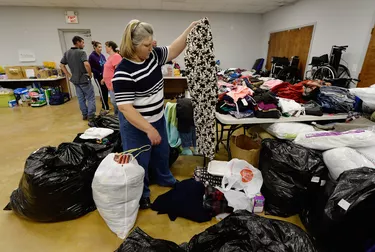
Your donations of money and thrift-store items to Goodwill Industries International Inc. help fund job training and job placement. As of 2022, Goodwill reported 155 community-based agencies, or chapters, and 3,200 thrift stores. If you estimate your donations in good faith, keep records and complete the required forms, you can gain some tax breaks and avoid questions by the Internal Revenue Service.
Donating Your Items
Video of the Day
When reviewing your Goodwill donation list, it is important to make sure that clothes, electronics, furniture, appliances, linens and other household wares must be in gently used or better condition. Broken items, clothes or furniture with holes or tears and non-working electronics likely won't qualify.
Video of the Day
The IRS has an exception to its good condition rule if you deduct more that $500 in noncash contributions and can furnish an appraisal for the item. Ask your local Goodwill chapter for a Goodwill tax deduction guide, or see the organization's online guide, for a suggested range of values, especially for items such as dresses, shoes, pants, shirts and suits.
Your Record of Giving
For monetary donations, you'll need to have a cancelled check, bank statement or receipt from Goodwill confirming its receipt. If your gift of money or property is $250 or more, the IRS requires you to get a written acknowledgement at the time of your donation. Goodwill says you can get a donation receipt when you drop off the goods, but you'll have the write in the description and your value estimate.
The acknowledgment must say whether you received anything in return and an estimated value. You don't send these documents with your tax return, but you should keep them in case the IRS audits you or questions your deductions.
Consider Also: Charitable Contributions: Tax Deductions & What You Need to Know
Amount of Deduction
Depending on how your Goodwill chapter is classified by the IRS. Donations to charitable organizations are typically between 30 and 60 percent of your adjusted gross income depending on the chapter.
Go to the IRS's Exempt Organizations Select Check tool at IRS.gov and type in your chapter's name. Click on the initials in the column "status." For example, if your Goodwill chapter is noted as "PC," then it is a public charity and you can typically report your contributions up to 60 percent of your adjusted gross income.
In 2021 the IRS changed the law to allow for 100 percent of the taxpayers AGI to be deducted, if the cash contributions were made to a qualifying charity. If you wish to go this route, you must choose the new limit, which is reduced by any other charitable contribution deductions you claim.
Filing a Form 8283
You must attach a completed Form 8283 if you give Goodwill more than $500 in property during the year. On the Form 8283, list the name and the employee identification number for the Goodwill chapter. The number is available from the Goodwill center or from the IRS' Exempt Organizations Select Check tool at IRS.gov. For any item or set of items greater than $5,000, attach the appraisal to the Form 8283 and have the appraiser sign the form.
Filing Schedule A
Report your deduction for gifts to Goodwill and other charitable organizations, such as churches, homeless shelters and schools, on Schedule A of Form 1040. You need to add the charitable deductions any other breaks you can claim on Schedule A, such as state and local taxes, home mortgage interest and medical expenses, to determine if itemized deductions or the standard deduction will provide you more tax relief.
The IRS also expanded their tax benefits in 2021 to allow taxpayers to claim up to $300 for cash contributions to qualifying charities, even if they opted to use standardized deductions. Those who file married are able to claim a total of $600.You won't need to use Schedule A for this but will instead find a special line on Form 1040.